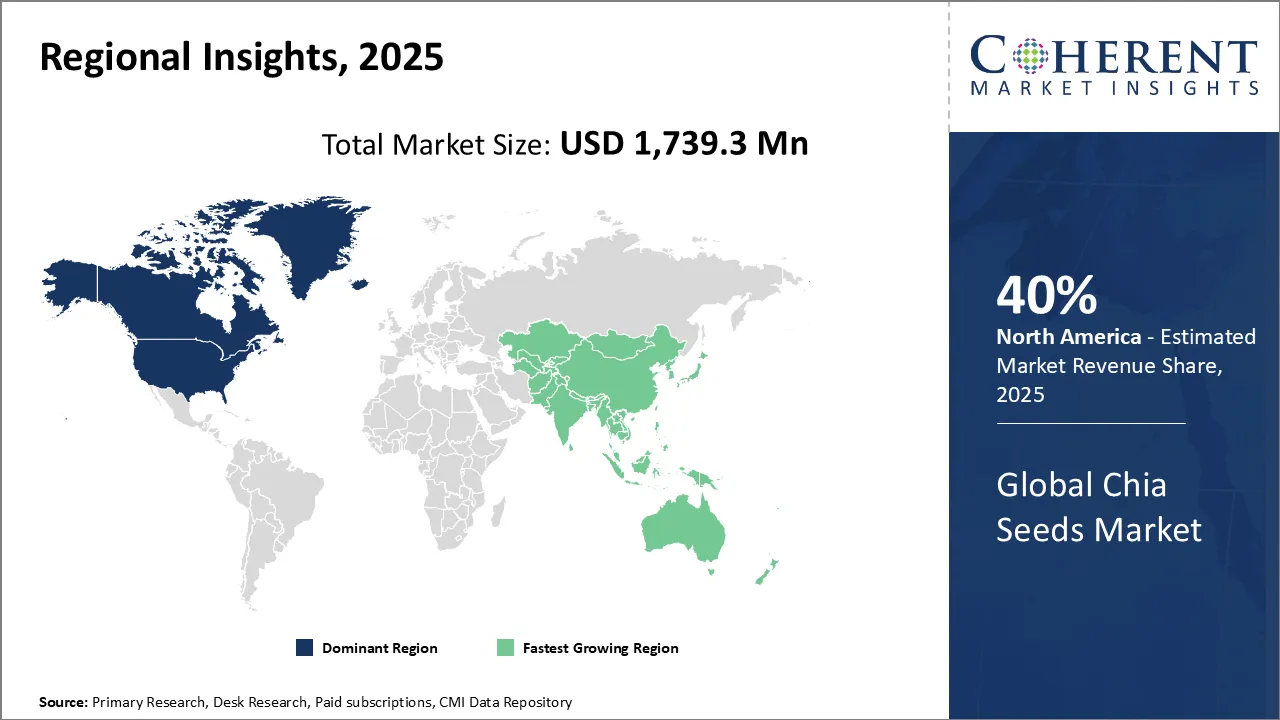The chia seed market is estimated to be valued at USD 1,739.3 Mn in 2025 and is expected to reach USD 3,942.2 Mn by 2032, exhibiting a compound annual growth rate (CAGR) of 12.4% from 2025 to 2032.
Chia seeds are gaining popularity among health-conscious consumers as a superfood. The nutrients in chia seeds provide several health benefits such as high fiber content, protein, antioxidants, and omega-3 fatty acids. The increasing awareness about the nutritional profile of chia seeds is driving its demand from the food and beverage industry. Major market players are investing in research and development to find new applications of chia seeds in various product categories such as bakery, cereals, beverages, and others. New product launches incorporating chia seeds are expanding globally which is expected to push the market revenue higher over the forecast period.
|
Current Events |
Description and its impact |
|
Regulatory Shifts Impacting Market Access |
|
|
Consumer Preference Evolution |
|
|
Climate Adaptation Investments
|
|
Uncover macros and micros vetted on 75+ parameters: Get instant access to report
The global chia seeds market is priced between $3–50/kg, influenced by certification, branding, and geography. Budget labels sell at $3–8/kg, while premium organic brands reach $25–50/kg. In the U.S., prices average $15–35/kg, with e-commerce offering 10–20% lower rates. Canada and the UK face higher premiums due to import costs. Companies are innovating, for instance, Navitas Organics positions its chia seeds at $26–33/kg, targeting health-conscious buyers. New applications, such as chia seeds in frankfurters (e.g., Marks & Spencer’s chia sausages) and chia seeds in animal feed, reflect growing demand.
Between October 2023 and September 2024, India exported a total of 1,157 shipments of chia seeds. These exports were carried out by 345 Indian exporters to 526 different buyers, representing a 32% increase compared to the previous twelve-month period.
In September 2024 alone, India shipped 102 consignments of chia seeds, reflecting a 29% year-on-year growth compared to September 2023, and a 19% increase from August 2024.
The primary destinations for India’s chia seed exports are Bangladesh, the United States, and the United Arab Emirates.
On a global scale, the leading chia seed exporters are India, Vietnam, and Mexico. India tops the list with 4,075 shipments, followed by Vietnam with 2,477 shipments, and Mexico in third place with 2,439 shipments.
Organic chia seed is leading the chia seeds market, accounting for a dominant 76.0% share in 2025. The rising preference for clean-label, chemical-free, and sustainably sourced food products has positioned organic chia seeds as the top choice among consumers. For example, in 2024, Navitas Organics expanded its organic chia seed product line in North America and Europe to meet growing demand from health-conscious consumers. Increasing awareness of wellness and the shift toward natural, environmentally responsible ingredients have made organic chia seeds the top choice in the market. The organic chia seed segment has gained significant traction as it aligns with the ongoing shift toward healthier diets and environmentally responsible farming practices.
The expansion of distribution channels—including supermarkets, hypermarkets, health food stores, and e-commerce platforms, which has further accelerated the adoption of organic chia seeds. Additionally, several food and beverage brands are integrating organic chia seeds into functional products such as energy bars, plant-based beverages, and breakfast cereals.
Consumers believe black chia seeds offer greater nutritional benefits than white and brown varieties. Many perceive them as richer in antioxidants like anthocyanins, which give the seeds their dark color and contribute to their health-promoting properties. These anthocyanins may help protect cells from damage linked to conditions such as diabetes and heart disease. As health concerns rise, more people are adding superfoods like black chia seeds to their diets to support wellness. Food companies have leveraged these perceived advantages by emphasizing the color and nutrient density of black chia seeds in their products. For instance, on average, chia seeds provide about 0.17 ounces of protein per ounce. Black chia seeds typically have a bit more protein than white chia seeds, but the difference is very small. This is further adding to the Chia seeds market share.
Food and beverage manufacturers are increasingly incorporating chia seeds into energy bars, breakfast cereals, baked goods, puddings, and other snacks to meet the preferences of health-conscious consumers. These seeds provide protein, fiber, and omega-3 fatty acids, while their gel-forming ability enhances texture and acts as a natural binder. This functionality helps companies create nutritious, convenient grab-and-go options. Manufacturers also use chia seeds in beverages—as mix-ins for infused waters and as thickeners in non-dairy milks and juices—thanks to their mild flavor and versatility.
To expand consumer choices, brands are launching innovative products like frozen desserts, dips, and spreads containing chia seeds. Rising demand for plant-based, clean label, and nutrient-rich packaged foods continues to fuel growth in the food and beverage segment. In April 2025, Mercadona launched the ultimate summer refresher! Introducing the passion fruit and chia juice from Mercadona’s own Hacendado brand—a standout addition to the Spanish supermarket’s beverage lineup. This exciting new drink blends the exotic, vibrant taste of passion fruit with the nourishing benefits of chia seeds.

To learn more about this report, Download Free Sample
The North American chia seed market acquires the largest market share with 40% as consumers increasingly prioritize wellness and health. Consumers are using chia seeds—rich in protein, fiber, and omega-3 fatty acids—in baked goods, energy bars, and smoothies. The rising popularity of plant-based and gluten-free diets is further driving demand. Whole chia seeds currently dominate the market; however, chia oil is growing at the fastest rate due to its health benefits and applications in personal care products. The U.S. leads the regional market, but Canada offers significant growth opportunities. As nutritional preferences evolve, retailers and food producers are actively incorporating chia seed-based products into their offerings.
In May 2025, Happy Belly Food Group Inc. innaugrated its 21st Heal Wellness location in Grand Bend, Ontario. Heal Wellness is a quick-serve restaurant specializing in fresh smoothie and acai bowls made with real fruit and superfoods like acai, pitaya, goji berries, and chia seeds.
Growing health consciousness, rising disposable incomes, and a growing desire for natural and organic products are driving the strong rise of the Asia Pacific chia seed market. Australia leads the world in both production and consumption, while countries with large populations and changing eating habits, such as China, Japan, and India, are emerging as key markets. The nutritional benefits and versatility of chia seeds in food and beverage applications further boost their appeal across the region. For Instance, India Gate Basmati Rice, the world’s largest basmati rice miller and exporter, and India’s first integrated rice brand with a full product chain, announced two new products for the domestic market: "Wholesome Health Special Chia Seeds" and "Active Heart Special Roasted Flax Seeds."
The growing popularity of plant-based diets and increasing health consciousness are driving significant development in the US chia seed market. Consumers are demanding chia seeds more as their adaptability allows incorporation into various culinary products such as baked goods, energy bars, and smoothies. The rising demand for clean-label and organic products also fuels market growth, as customers actively seek natural and minimally processed ingredients.
However, price volatility and limited domestic production may pose challenges that could impact the market’s growth trajectory. For Instance, in March 2025, Benexia, a manufacturer of chia-based products, introduced a new plant-based milk substitute called Seeds of Wellness Chia Milk in the United States. The company reports that the product provides 740 mg of plant-based omega-3 fats per 8 oz serving and is the first plant-based milk made from whole chia seeds.
Gen Z and millennials in cities are increasingly popularizing chia seeds, using them in baked goods, energy bars, and smoothies. Retailers are expanding chia seed availability through tier-2 and tier-3 city retail channels, health food stores, and online marketplaces. Packaging innovations, such as single-serving pouches and resealable bags, are enhancing consumer accessibility and convenience. However, higher costs compared to other seeds and low awareness in rural areas could limit wider adoption. Despite these challenges, the growing middle class and rising demand for functional foods continue to drive the market’s growth potential.
For Instance, In March 2023, Well-known actor Samantha Ruth Prabhu invested in Nourish You, a company that promotes sustainable and locally sourced supermarket foods. As the first retailer of domestically cultivated quinoa and chia seeds in India, Nourish You continues to lead the chia seed industry.

To learn more about this report, Download Free Sample
| Report Coverage | Details | ||
|---|---|---|---|
| Base Year: | 2024 | Market Size in 2025: | USD 1,739.3 Mn |
| Historical Data for: | 2020 To 2024 | Forecast Period: | 2025 To 2032 |
| Forecast Period 2025 to 2032 CAGR: | 12.4% | 2032 Value Projection: | USD 3,942.2 Mn |
| Geographies covered: |
|
||
| Segments covered: |
|
||
| Companies covered: |
The Chia Co, Glanbia Nutritionals, Inc, BENEXIA, Naturkost de México, Bioriginal Food & Science Corp, Mamma Chia, Navitas Organics, Bob’s Red Mill Natural Foods, Inc., Spectrum Organic Products, LLC, Salba Smart Natural Products, Garden of Life LLC , Nutiva Inc., Organic Denmark, Hodmedod , Mercadero, K V Agro Products, ROYAL NUT COMPANY, Grenera Nutrients Pvt Ltd, Green Farm, and The Kenya chia seed co. LTD. |
||
| Growth Drivers: |
|
||
| Restraints & Challenges: |
|
||
Uncover macros and micros vetted on 75+ parameters: Get instant access to report
Manufacturers are actively innovating in product forms and delivery methods to meet diverse consumer preferences. They offer chia seeds in various forms—whole, pre-hydrated, milled/ground, and oil—to cater to different nutritional needs and culinary uses. Additionally, the rise of e-commerce and online retail platforms has expanded access, allowing customers to conveniently purchase a wide range of chia-based products.
Consumers are increasingly driving demand for sustainability and ethical sourcing in the chia seed sector. Chia production supports this shift, as it uses less water and thrives under organic farming methods. In response, businesses are actively adopting sustainable agricultural practices and ensuring transparent sourcing to align with consumers' ethical and environmental values.
There are significant opportunities for chia seed producers and sellers to tap into new regional markets that have seen little chia seed cultivation or consumption to date. Many South American and African nations have ideal growing conditions for chia but lack widespread production infrastructure. With education and support, farmers in countries like Brazil, Colombia, Nigeria and Ethiopia could efficiently cultivate chia, giving their populations and export markets new access to this nutrient-dense seed. As awareness of health benefits grows globally, demand will rise beyond traditional markets. If production networks develop in underutilized areas, they will help meet demand and provide economic opportunities for small-scale growers.
Share
Share
About Author
Sakshi Suryawanshi is a Research Consultant with 6 years of extensive experience in market research and consulting. She is proficient in market estimation, competitive analysis, and patent analysis. Sakshi excels in identifying market trends and evaluating competitive landscapes to provide actionable insights that drive strategic decision-making. Her expertise helps businesses navigate complex market dynamics and achieve their objectives effectively.
Missing comfort of reading report in your local language? Find your preferred language :
Transform your Strategy with Exclusive Trending Reports :
Frequently Asked Questions
Joining thousands of companies around the world committed to making the Excellent Business Solutions.
View All Our Clients